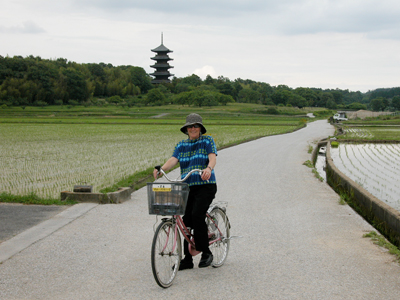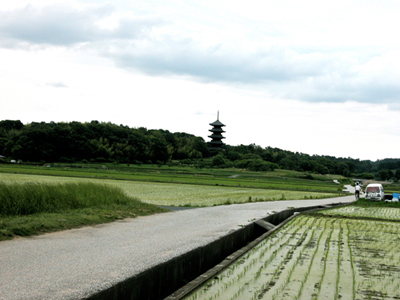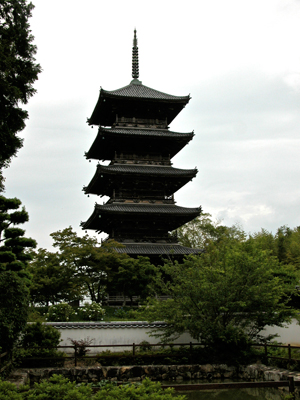I've been reading with interest A Father and Son's Bike Adventure Across Japan, blogs posted on this website about the duo's 67-day, 2,500 journey. What an adventure for both of them! I love the outdoors and I love to bike (preferably on flat terrain—hey, I'm from Kansas!) but devoting two months to a vacation is beyond the scope of my possibilities.
That's why, when I'm in Japan working, I'm always on the lookout for short biking and hiking excursions that will transport me from the city into the countryside. I've mentioned some of my favorites in previous blogs: Cycling the Seto Inland Sea, about the biking path that hopscotches across islands and bridges from Shikoku to Hiroshima Prefecture; Path of the Daimyo, about a hike with my teenage son on the old Nakasendo Highway; Solitude in Hokkaido, describing three short walks in this northern prefecture. I also love cycling through the Kibiji District in Okayama Prefecture. Not only does the bike path take you through the ancient Kibi Kingdom with its old burial grounds, five-story pagoda, shrines and other sites, but it also traverses beautiful pastoral countryside.
It takes a little more than a half hour by local train from Okayama Station to Soja Station, where you will find a rental-bike shop next to the station and can pick up a free map of the 10-mile bike path to Bizen-Ichinomiya Station. You should plan on about three hours for the ride if you want to stop at sites along the way. Although you could conceivably cycle back to Soja Station to return the bike, it's worth paying the extra drop-off fee at Ichinomiya Station (Ichinomiya Station, along with other locations in the Kibiji District, also rents bikes).
A three-hour ride, plus the drop-off fee, costs about 1,200 Yen. After ditching your bike at Ichinomiya Station (make sure you get there before the bike rental window closes at 6pm), it's only an 11-minute train ride back to Okayama Station. The Kibiji District was once the center of the Kibi Kingdom, which flourished from the end of the Yayoi Period (around 300 A.D.) until about the 6th century. The most distinguishing remains of this ancient people are the hill-shaped royal tombs they left behind, including the Tsukuriyama Burial Mound you'll pass by on your bicycle. At 938 feet long, it's the 9th largest burial mound in Japan. Farther along is the pictorial highlight of the trip, the five-story pagoda, constructed in 1844. The most important building to see, however, is probably Kibitsu Shrine, last rebuilt in 1425 and once serving as the head shrine of the entire Kibi Kingdom.
Most Japanese know the national treasure for its tale about a demon, which is said to have deflected arrows shot by a prince with boulders until outwitted by two arrows shot at once, one of which hit the demon's eye. Although the demon escaped by turning himself into a carp and swimming away, the prince became a cormorant and finally ate the demon at nearby Koikui Shrine.
It's fun having these and other sights to stop off and see along the way, but what I most relish about this ride are the ordinary things you see, just everyday rural life. Although part of the path is a dedicated biking and hiking path (signs with “Kibiji District" written on them and a picture of a bike point the way), much of the path simply follows the same paved, raised beds ringing paddies that farmers use to walk to their fields. You'll pass farmers working in their paddies and fields, both children and heron fishing for their next meal, peach groves, and woods. I got lost a couple of times (signs are scarce near Bizen-Ichinomiya Station), but villagers are apparently used to lost cyclists and soon had me merrily on my way. For a few hours, I was part of this rural landscape, making it a great escape from city life.































































